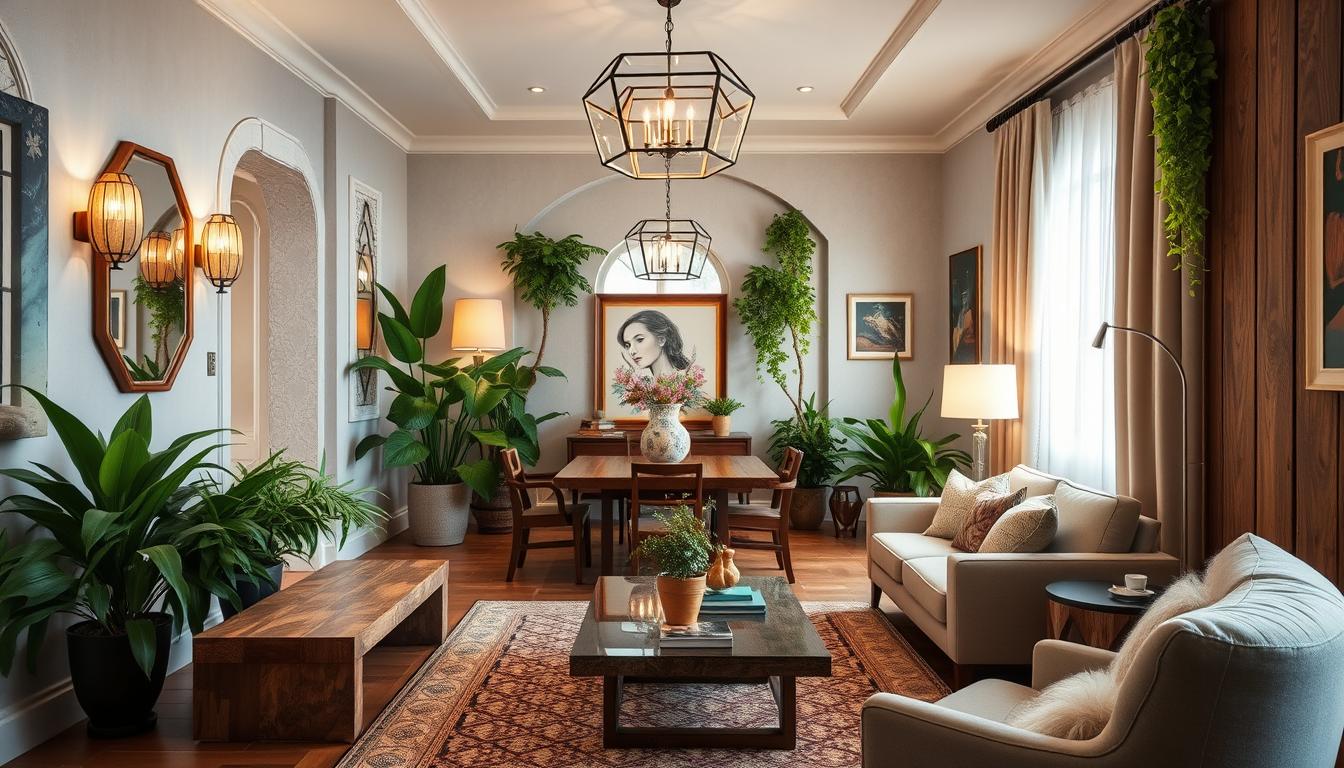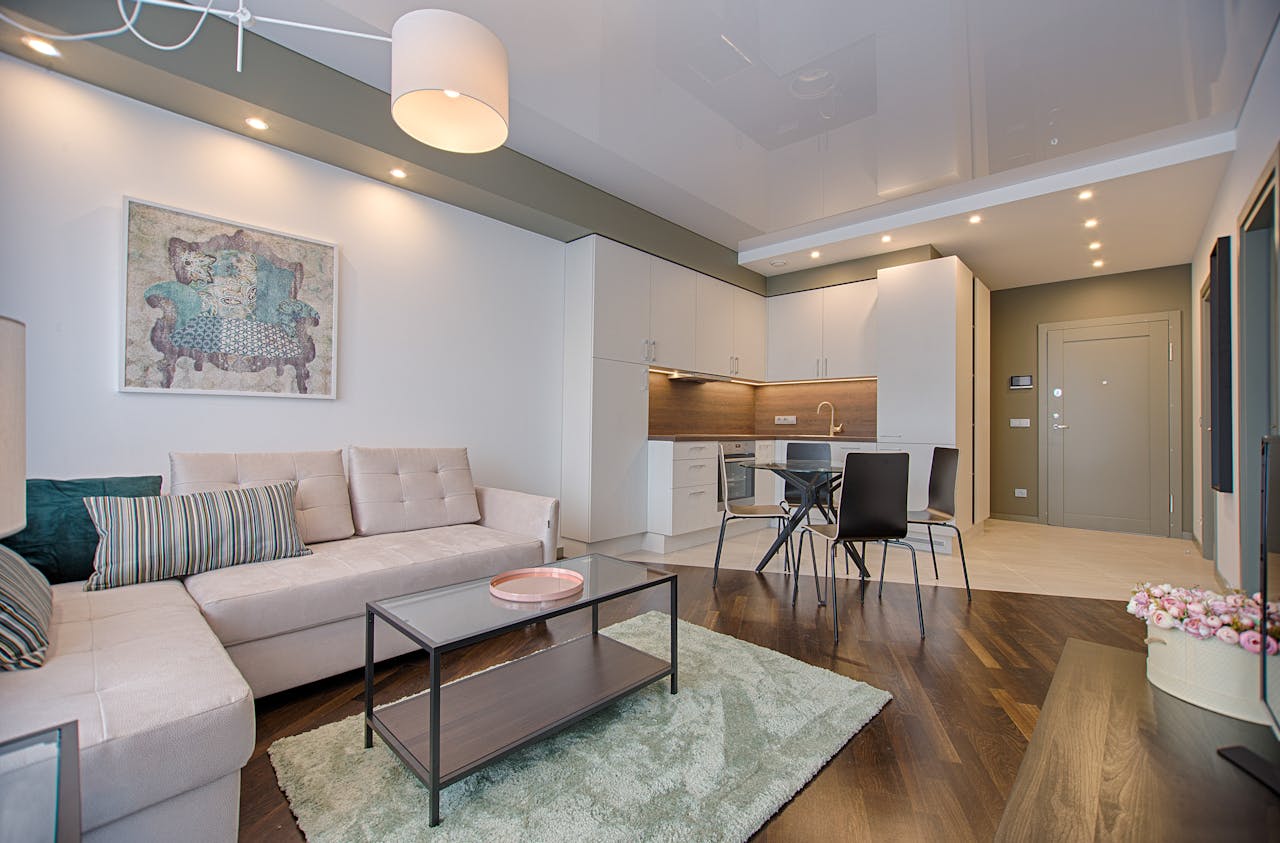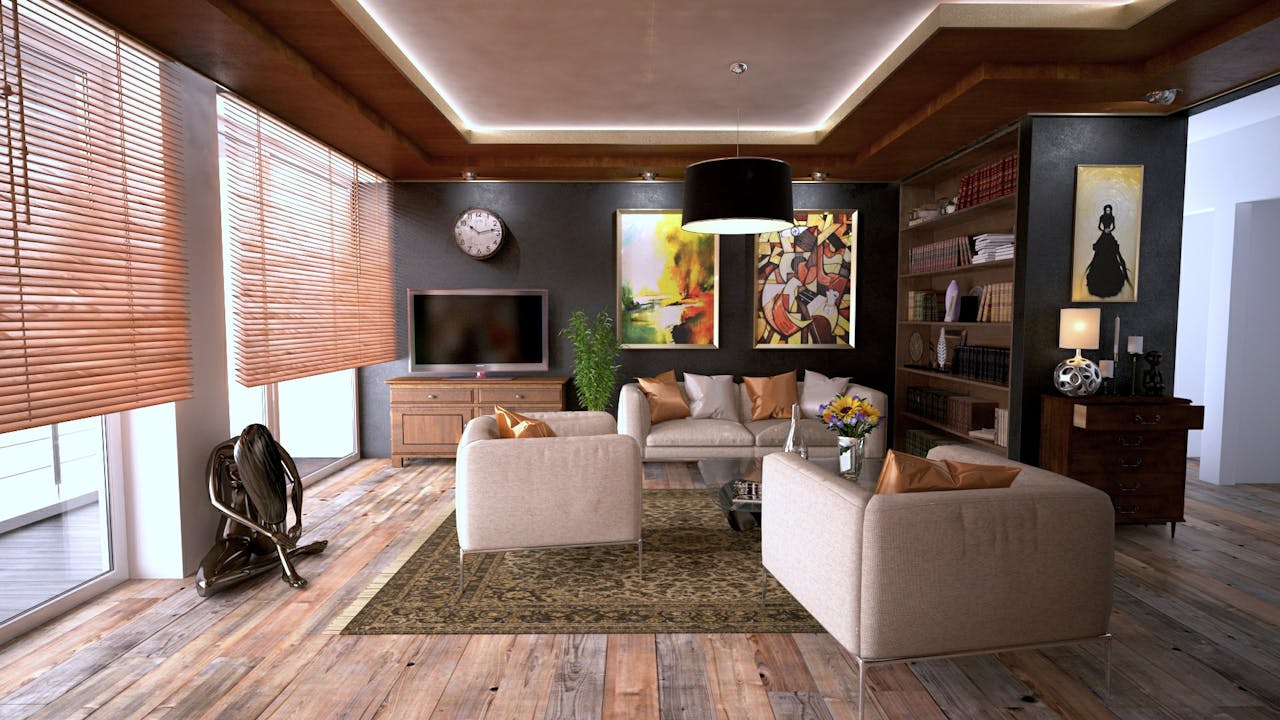The world of home decor is vast and varied. There are over 100 different styles to choose from. Homeowners can create a space that shows their personality and taste.
Exploring interior design styles can be both exciting and overwhelming. Each style, from classic to contemporary, has its own charm. Knowing these styles helps homeowners make better decorating choices.
We will look at timeless styles and the latest trends. We’ll give tips on how to bring these styles into your home.
Key Takeaways
- Understanding different styles helps homeowners make better decorating choices.
- Classic and contemporary styles are very popular.
- Each style has its own charm and characteristics.
- Homeowners can mix elements from various styles for a unique look.
- Staying up-to-date with trends helps choose the right style for your home.
Understanding the Importance of Interior Design Styles
Knowing about interior design styles is crucial for a welcoming home. The right style can change a room’s feel. Finding your favorite style is the first step.
Why Interior Design Styles Matter
Interior design styles are important for a beautiful and useful space. The right style makes a room feel cozy, stylish, and inviting. For example, modern interior design uses simple designs and new materials. Traditional interior design adds classic touches and detailed decor.
Here are some reasons why styles are key:
- They make a home look cohesive.
- They show off your personal taste.
- They affect a room’s feel and use.
Creating a Cohesive Look
A unified look is vital for a welcoming space. Choosing a style that connects furniture, colors, and textures is essential. For instance, if you like modern design, pick furniture and decor that match, like simple shapes and clean lines.
Reflecting Personal Taste
Interior design styles show your personal taste. Whether you love traditional elegance or modern simplicity, your style should feel like home. It’s about making a space that shows who you are and fits your life.
Here are ways to show your taste:
- Add personal items and family treasures to your decor.
- Choose colors and textures you adore.
- Try out different styles to see what suits you best.
Classic Interior Design Styles
The world of interior design is filled with classic styles that have lasted for ages. Each style has its own charm and character. They bring elegance, sophistication, and comfort to our homes.
Classic designs use rich colors, intricate patterns, and ornate furnishings. They take inspiration from history, keeping elements loved for generations. Let’s look at some classic styles that still shape home decor today.
Traditional Design
Traditional design is a favorite, known for its elegant and harmonious feel. It’s inspired by 18th and 19th-century European designs. It features rich wood tones, intricate moldings, and plush furnishings.
A traditional interior often uses warm colors and classic patterns like stripes and florals.
Victorian Elegance
Victorian elegance is known for its opulence and refinement. It uses dark, rich colors and elaborate furnishings. Victorian interiors are dramatic and luxurious.
This style loves bold patterns, heavy drapery, and ornate accessories.
“The Victorian era’s love for ornamentation and luxury has left a lasting legacy in the world of interior design, inspiring a sense of grandeur and sophistication that continues to captivate homeowners today.”
Colonial Influences
Colonial influences add history and cultural heritage to design. This style uses natural materials, classic furniture, and a subdued color palette. Colonial interiors are cozy and inviting, focusing on comfort and practicality.
| Style | Key Features | Color Palette |
|---|---|---|
| Traditional Design | Rich wood tones, intricate moldings, plush furnishings | Warm, inviting colors |
| Victorian Elegance | Dark, rich colors, elaborate furnishings, bold patterns | Deep reds, greens, and golds |
| Colonial Influences | Natural materials, classic furniture, subdued colors | Earth tones, muted pastels |
Each classic style offers a unique look that can match personal tastes. By knowing these styles, homeowners can create a beautiful and meaningful home.
Modern Interior Design Styles
Modern interior design is all about clean lines and minimal decoration. It started in the early 20th century and has grown to include many styles. These styles meet different tastes and needs.
Minimalism
Minimalism focuses on simplicity and less clutter. It uses:
- Neutral colors
- Simple shapes and clean lines
- Little patterns and textures
- Function over decoration
Minimalist design brings calm and peace to homes.
Industrial Design
Industrial design takes inspiration from old factories. It features:
- Exposed brick and concrete
- Metal and reclaimed wood
- Open layouts and high ceilings
- Vintage and modern furniture
It’s great for those who love the raw, unfinished look.
Scandinavian Simplicity
Scandinavian design comes from Nordic countries. It emphasizes:
- Light colors and natural materials
- Little decoration and clean lines
- Function and practicality
- Nature through natural textures
This style makes homes warm and welcoming.
In summary, modern interior design offers many choices for creating unique, functional spaces. Knowing about minimalism, industrial design, and Scandinavian simplicity helps in making the right design choices.
Rustic Interior Design Styles
Rustic interior design is perfect for those who love natural materials. It combines coziness with functionality. This style uses organic elements, a neutral color palette, and focuses on being practical. It makes any home feel warm and welcoming.
Farmhouse Charm
Farmhouse charm is a key part of rustic design. It uses vintage or antique furniture, natural wood, and classic country elements. This style makes homes feel cozy and welcoming, ideal for families.
Key elements of farmhouse charm include:
- Vintage or antique furniture
- Natural wood accents
- Classic country decor
- Neutral color palette
Cottage Style
Cottage style is another favorite rustic design. It brings warmth and coziness to any space. It uses soft colors, comfy furniture, and decor that shows a relaxed lifestyle.
Cottage style aims to make a space feel like a cozy retreat. It’s great for those who dream of a secluded, comfortable home.
| Design Element | Cottage Style Characteristics |
|---|---|
| Color Palette | Soft pastels, whites, and creams |
| Furniture | Comfortable, plush furnishings |
| Decor | Floral patterns, vintage items |
Mountain Lodge Aesthetic
The mountain lodge aesthetic brings the outdoors inside. It uses natural materials like wood and stone, and earthy colors. It also features large furniture for a cozy, lodge-like feel.
Characteristics of the mountain lodge aesthetic include:
- Natural materials like wood and stone
- Earthy color palette
- Large, comfortable furnishings
- Decorative elements like antlers or vintage ski equipment
By using these rustic design styles, you can make your home warm and inviting. It will show off your personal style and taste.
Eclectic Interior Design Styles
Eclectic interior design lets you show off your style. It’s all about mixing different things to make a space that’s uniquely yours.
At its heart, eclectic design is about personal expression. It lets you play with various styles, patterns, and textures. This leads to spaces that are both interesting and personal.
Mixing Patterns and Textures
Mixing patterns and textures is key in eclectic design. You can blend old furniture with new decor, or mix bold patterns with soft textures. The goal is to create a look that’s engaging but not too much.
For ideas on mixing patterns and textures, check out eclectic interior design ideas. These show how versatile this style can be. By using different elements, you can make a space that feels carefully put together.
Cultural Influences
Eclectic design often includes items from various cultures. This adds depth and character to a room. You can use traditional textiles, artifacts, or decorative items that show off a culture.
By using cultural influences, you can make your space tell a story. It becomes more than just a place to live. It shows off your travels, interests, and values.
Personal Expression
At the core of eclectic design is personal expression. It’s about making a space that truly reflects you. You can use personal items, artwork, or unique decor to express yourself.
This style is more than just looks. It’s about making a home that feels like you. With eclectic design, you can create a space that’s truly unique.
Contemporary Interior Design Styles
Contemporary interior design is all about change and new ideas. It’s not stuck to one look but takes in many styles. This includes modern art and the latest tech.
Fluidity and Innovation
What makes contemporary design special is how it keeps up with the times. Designers are always trying new things. They use new materials and ideas to keep their designs fresh.
They also use new materials and tech. For example, they choose green materials and energy-saving solutions. This makes the space look good and helps the planet.
Functional Aesthetics
Contemporary design focuses on looks and use. It aims to make spaces that look great and work well. This is done with simple designs and a focus on what works.
| Design Element | Description | Benefit |
|---|---|---|
| Clean Lines | Simple, uncluttered design | Creates a sense of openness and clarity |
| Minimal Ornamentation | Reduced use of decorative elements | Enhances the sense of space and reduces visual clutter |
| Functional Layout | Practical arrangement of furniture and fixtures | Improves usability and efficiency of the space |
Use of Technology
Technology is a big part of contemporary design. It’s used to make spaces better to use and look at. This includes smart homes and advanced lights.
For instance, smart lights can change color and brightness based on the time or what you’re doing. Smart homes manage everything from security to fun, making life easier.
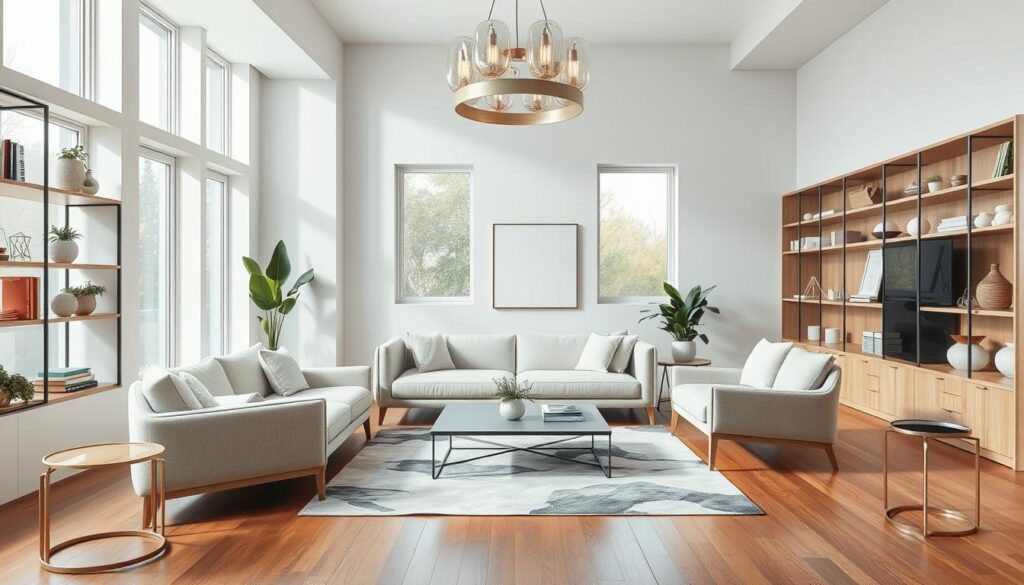
Coastal and Nautical Interior Design Styles
Coastal interior design brings the calm of the ocean into your home. It uses natural materials and soft colors. This style creates a relaxed, casual feel.
Beach House Vibes
A beach house vibe captures the essence of a seaside retreat. It uses light colors and natural textures. To get this look, add:
- Soft whites and creams
- Driftwood and reclaimed wood
- Nautical accents like anchors and ropes
Color Palettes Inspired by the Sea
The color palette is key in coastal design. It often includes blues, greens, and sandy neutrals. Some favorite combinations are:
| Color | Inspiration | Example Use |
|---|---|---|
| Soft Blues | Calm ocean waters | Walls and bedding |
| Sandy Neutrals | Beach sand | Furniture and trim |
| Seafoam Greens | Ocean tides | Accent pieces and decor |
Natural Materials and Textures
Natural materials and textures are vital in coastal design. Wicker, jute, and linen add depth and warmth. They make your space cozy and inviting.
Key natural materials include:
- Wicker and rattan furniture
- Jute and linen textiles
- Driftwood and reclaimed wood accents
Using these elements, you can make a coastal design that’s both stunning and practical.
Mid-Century Modern Design
Mid-century modern design is known for its clean lines, organic shapes, and mix of materials. It emerged in the mid-20th century. This style is not just about looks; it’s also about being functional and simple.
Key Characteristics
Mid-century modern design stands out for several reasons. Clean lines and minimal ornamentation make spaces feel open and simple. The use of organic shapes adds warmth and sophistication. Also, large windows and sliding glass doors connect indoors with outdoors, making spaces feel bigger.
Color and Material Trends
The color palette in mid-century modern design includes earth tones and bold colors. Earthy tones like walnut and oak are paired with pops of color from furniture and decor. The focus is on wood, leather, and metal materials. These add durability, warmth, and texture to a room.
Notable Furniture Designs
Mid-century modern design is famous for its iconic furniture. Designers like Charles and Ray Eames, Eero Saarinen, and George Nelson created pieces that were both functional and beautiful. The Eames Lounge Chair and Saarinen’s Tulip Table are perfect examples. They showcase innovative materials and sculptural forms.
| Design Element | Description |
|---|---|
| Clean Lines | Minimal ornamentation, emphasis on simplicity |
| Organic Shapes | Egg-shaped chairs, rounded coffee tables |
| Material Mix | Wood, leather, metal, and glass |
| Color Palette | Earth tones with pops of bold colors |
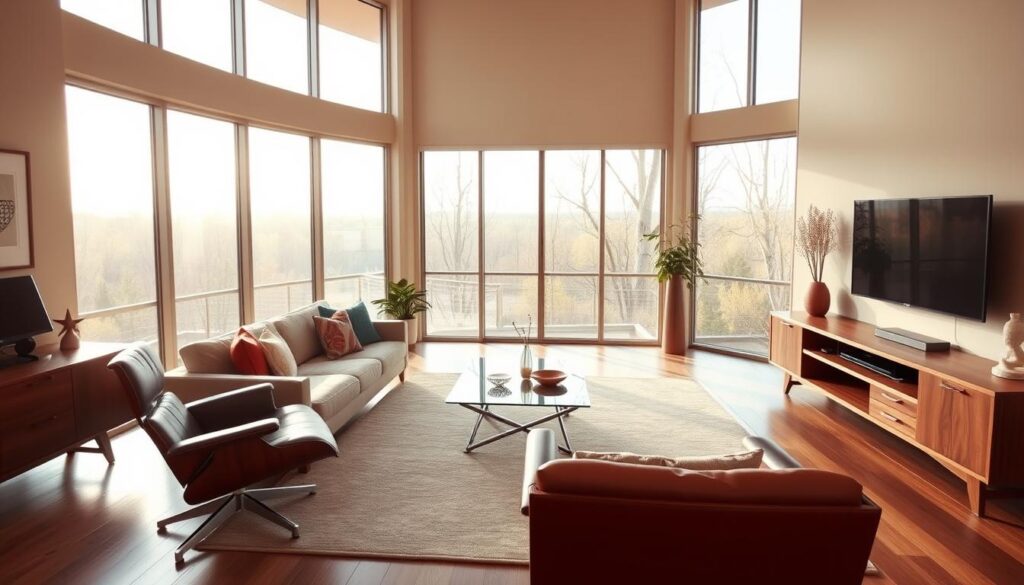
In conclusion, mid-century modern design is a timeless style that captivates with simplicity, functionality, and innovative materials. By incorporating this style into our homes, we honor its history and embrace a timeless aesthetic that improves our living spaces.
Urban and Loft Styles
In interior design, urban and loft styles are known for their creative space use. They’re popular in modern homes, where space is tight.
Open Concept Living
Open concept living is a key feature of these styles. It means fewer walls for a more open feel. Living, dining, and kitchen areas blend into one big space.
“The open concept is not just about removing walls; it’s about creating a flow that connects different areas of the home,” says an interior design expert. This style makes homes feel more connected.
Urban Chic Decorations
Urban chic decorations are all about style. Think exposed brick, metal beams, and simple decor. These elements make a space look sleek and modern.
- Exposed brick and concrete
- Metal accents and beams
- Minimalist decor and furniture
Creative Use of Space
Urban and loft designs are all about making the most of space. Designers use smart furniture and decor that does double duty. This is key in small urban homes.
For example, a storage ottoman can be a seat and a place to store things. A murphy bed can fold up, saving floor space.
Tips for Choosing the Right Interior Design Style
Choosing the right interior design style for your home can be tough. But, by thinking about a few key things, you can make a good choice. We’ll help you figure out what works best for your space, lifestyle, and needs.
Space Assessment
Understanding your space is key to picking the right design. Look at the size, shape, and how much light it gets. This helps you pick the best layout and design.
Lifestyle Considerations
Your lifestyle affects your design choice. Think about your daily life, what you like, and what you need. For example, a big family might need a design that’s practical and lasts long.
Balancing Trends and Functionality
It’s important to mix current trends with practicality. Add trendy touches that still make your space useful. This way, your home will look great and work well for you.
By using these tips, you can pick the perfect design for your home. It will be both beautiful and useful. This means finding a style that fits your needs perfectly.

